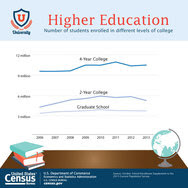
College enrollment declined by close to half a million (463,000) between 2012 and 2013, marking the second year in a row that a drop of this magnitude has occurred. The cumulative two-year drop of 930,000 was larger than any college enrollment drop before the recent recession, according to U.S. Census Bureau statistics from the Current Population Survey released today. The Census Bureau began collecting data on college enrollment in this survey in 1966.
As the nation’s students and teachers return to the classroom, the Census Bureau has published School Enrollment in the United States: 2013, detailing national-level statistics on the characteristics of students, from nursery school to graduate school. The data were collected in the October School Enrollment Supplement to the 2013 Current Population Survey.
“The drop-off in total college enrollment the last two years follows a period of expansion: between 2006 and 2011, college enrollment grew by 3.2 million,” said Kurt Bauman, chief of the Census Bureau’s Education and Social Stratification Branch. “This level of growth exceeded the total enrollment increase of the previous 10 years combined (2.0 million from 1996 to 2006).”
According to the new statistics, the drop in enrollment was equally divided between older and younger students. Enrollment of students 21 and younger fell by 261,000; the enrollment of students older than 25 fell by 247,000, not statistically different from the change in enrollment of students 21 and younger. Overall, 40 percent of those 18 to 24 were enrolled in college in fall 2013, after having reached 42 percent in 2011.
A large part of the decline took place in two-year colleges (known often as community or junior colleges). Such schools experienced a 10 percent decline in enrollment from 2012 to 2013, while enrollment at four-year colleges grew slightly (1 percent).
Hispanic college enrollment stopped its growth in 2013 after seeming to defy the overall downward trend in 2012. A larger share of Hispanic college students attend two-year schools than Asians, blacks or non-Hispanic whites, and these schools saw a sharper decline than four-year schools.
“By looking at these statistics over time, researchers can look for trends about how business cycles affect college enrollment,” Bauman said.
Hispanic college enrollment did not grow between 2012 and 2013, after having increased by 1 million during the previous five years (2007 to 2012). Black college enrollment also did not grow after a climb of 500,000 in the previous five years. College enrollment of Asians increased by 340,000 from 2007 to 2012, but also did not grow between 2012 and 2013.
The tables provide information by age, sex, race, Hispanic origin, family income, type of college, employment status, nativity, foreign-born parentage, attendance status (full or part time), control of school (public or private) and vocational course enrollment. They explore issues such as nursery school and kindergarten enrollment, the likelihood of being enrolled below modal grade and the percentage of young adults enrolled in college. Historical tables are also provided.
Other highlights include:
All levels
· In 2013, 78 million people, or 25.9 percent of the population 3 years or older, were enrolled in school.
· Students who were born in another country or whose parents were foreign-born made up 25.8 percent of all those enrolled in school at all levels in 2013.
· Across all levels of enrollment, non-Hispanic whites made up 54.0 percent of students. Hispanics were 21.8 percent, blacks 15.2 percent and Asians 5.6 percent.
· The number of blacks enrolled in school at all levels increased by 3.6 percent from 2003 to 2013. The increase was 32.1 percent for Asians and 42.3 for Hispanics over the same period.
Precollege
· In 2013, there were 4.3 million students enrolled in private elementary and high schools (kindergarten through high school), down from 4.6 million in 2012. Public school enrollment did not rise over the period.
· In 2013, non-Hispanic white children comprised 52.7 percent of elementary school students (grades 1-8), down from 59.1 percent in 2003. Non-Hispanic white students made up 47 percent of kindergarten students in 2013, compared with 60 percent a decade earlier.
College
· In 2013, there were 19.5 million college students, including 5.3 million in two-year colleges, 10.5 million in four-year colleges and 3.7 million in graduate school.
· At the college level, 58.2 percent of students were non-Hispanic white. Hispanics comprised 16.5 percent, blacks 14.7 percent and Asians 8.1 percent.
In time for the re-opening of the nation’s schools, the Census Bureau released an innovative new tool: Census PoP Quiz. Teachers can use this interactive mobile app in their classrooms to introduce students, in an interactive format, to demographic statistics about each of the 50 states and the District of Columbia. |
No comments:
Post a Comment